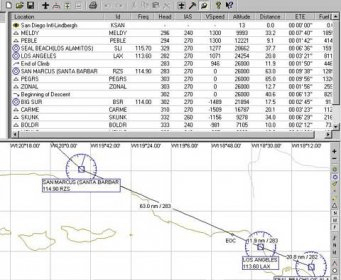
We can cover that `sight picture` thing later. Once you stop aiming for the runway and instead aim for a point well in front of the runway, everything gets much, much easier.

When learning to fly for real the two biggest `earners` for me in terms of enabling more control and better landings were the `extended centreline` and the `sight picture` through the windscreen. Reason? Becaause you don't want to be making tight turns or many small adjustments when you are busy descending on final approach. Typically this will be a point you pick about a mile or two out. The only thing that is needed is remember that you are NOT trying to line up with the runway, you are trying to line up with a point some way extended toward you from the runway - the `extended centreline`. 230 degrees) is not gong to much other provide an approach between 236 and 245 degrees.

It quickly becomes intuitive with a bit of experience as it is obvious that an approach to Runway 23 (i.e. The FS Navigator program includes details for each and every ILS and a pictorial reference for it's operating `cone` as Alastair describes it.

This may take a little time to grasp, but with a bit of practice you'll soon get the hang of it. You'll see when you're about to enter the "cone" and can then watch for the VOR gauge to become active. I agree with Simon about FSNavigator - ideal to "picture" what's going on and it gives you the opportunity to monitor things. On the right, glide-slope needle is high, you are below the glide-path and must fly up, toward the needle to return." In the center, both needles are centered, aircraft is on glide path and localizer – your approach is perfect. "On the left, glide-slope needle is low, you are above the glide-path and must fly down, toward the needle to return. If your VOR unit is set to the correct frequency and the needle adjusted to the correct heading, when you enter the cone the two guidance lines will appear: Think of the ILS as a cone expanding out and up from the end of the runway:Īim to approach the runway you aim to land at at a slight angle, and below the altitude the cone will be when you fly into it. You should be able to answer most of your questions about VOR/ILS navigation by using this tool, along with the tutorial website I mentioned earlier. Moving map display means you can actually see where you are in real time and (unlike the GPS units) the map displays ALL the beacons, ILS's navaids and intersections WITH their names and frequencies - and the mouse hovered over them gives you bearing, range and other information about them - useful when you want to know the altitude of the airport you're approaching as, if you want to be 1,500 feet above the runway at 5 miles out, you don't want to be at 1,500 feet altitude when the runway is at 1,600.!įor you the big gains are the 20 `try before buy` goes it gives you. This addon provides a pictorial (a MAP!) reference to the sim world and acts (depending on the level you want) as everything from that map-in-your-lap all the way to sophisticated GPS-cum-Flight Management Computer. I'm assuming you're new to this game so let me make just a single purchase recommendation for something OUTSIDE of Flight 1 (sorry boys!) that will provide the absolute perfect introduction to navigation in the sim world. Acquiring the ILS is a knack, simlpy because it varies from airplane to airplane, even from ILS to ILS. Obviously GPS has displaced VOR as the primary source of navigation info in the modern cockpit but being able to understand the various beacons and radio aids is crucial to complete awareness in the air.įor us simmers, we have the luxury of the `pause` and the `reset` keys and websites like this and the one I referred to - a vast pool of knowledge and the scope to practice it in a repeatable manner.

You could also navigate directly toward or away from the beacon. With one beacon and a range-to signal you could even do that with just a single source, or you could triangulate those two sources again to verify where you are. Where the lines crossed, well that was where you are! In the pre-GPS days you had two VOR stations which you manually triangulated on the map on your lap in the airplane. Yep, VOR's are OMNI-directional beacons that send a radio signal out in all directions to give a receiver bearing (and often distance) to or from the receiving station as an aid to navigation. Just l ook at where you've got to in a couple of days! It's coming together very nicely and you're finding out one of the really great thnigs about Flight Simming - it's about the journey, just as much as the arrival!


 0 kommentar(er)
0 kommentar(er)
